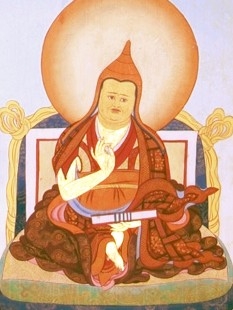Ketaka Gem: Difference between revisions
(ISBN.) |
m (→Notes=) |
||
| (3 intermediate revisions by 2 users not shown) | |||
| Line 1: | Line 1: | ||
[[Image:Mipham.JPG|frame|'''Mipham Rinpoche''']]'''The Ketaka<ref> | [[Image:Mipham.JPG|frame|'''Mipham Rinpoche''']]'''The Ketaka<ref>''Ketaka'' is a gemstone that is said to be able to purify dirty water.</ref> Gem''' (Tib. ནོར་བུ་ཀེ་ཏ་ཀ་, ''Norbu Ketaka'', [[Wyl.]] ''nor bu ke ta ka'') — a commentary on the ninth chapter of the [[Bodhicharyavatara]] written by [[Mipham Rinpoche]], based on the teachings of [[Patrul Rinpoche]]. It was composed in 1878, when Mipham Rinpoche was 32. | ||
''Ketaka'' is a gemstone that is said to be able to purify dirty water.</ref> Gem''' (Tib. ནོར་བུ་ཀེ་ཏ་ཀ་, Norbu Ketaka, Wyl. ''nor bu ke ta ka'') | |||
Lhobpon Rechunpa said: | Lhobpon Rechunpa said: | ||
:From the emanation of [[Lokeshvara]], Dza Paltrul Rinpoche, [Mipham Rinpoche] received the Wisdom Chapter of the Bodhicharyavatara in only five days. Based on this, he wrote the commentary on the Wisdom Chapter known as the She Drel Keta Ka. <ref>''Biography of Jamgon Ju Mipham Rinpoche Namgyal Gyatso'' by Lhobpon Rechungpa and Eric Forgeng (see rangjung.com)</ref> | :From the emanation of [[Lokeshvara]], Dza Paltrul Rinpoche, [Mipham Rinpoche] received the Wisdom Chapter of the Bodhicharyavatara in only five days. Based on this, he wrote the commentary on the Wisdom Chapter known as the She Drel Keta Ka.<ref>''Biography of Jamgon Ju Mipham Rinpoche Namgyal Gyatso'' by Lhobpon Rechungpa and Eric Forgeng (see rangjung.com)</ref> | ||
Mipham Rinpoche himself said: | Mipham Rinpoche himself said: | ||
:“When I was young, I was present when many accomplished, learned lamas gave Dharma teachings, but I only seriously studied Dza Patrul Rinpoche’s teachings on the Wisdom Chapter of the Bodhicharyavatara. Later, in dependence on the kindness of my venerable lama and Manjushri, no difficulties with study ever arose for me.” | :“When I was young, I was present when many accomplished, learned lamas gave Dharma teachings, but I only seriously studied Dza Patrul Rinpoche’s teachings on the Wisdom Chapter of the Bodhicharyavatara. Later, in dependence on the kindness of my venerable lama and [[Manjushri]], no difficulties with study ever arose for me.” | ||
In the ninth chapter of [[Nectar of Manjushri's Speech]], [[Khenpo Kunpal]]'s commentary on the whole ''Bodhicharyavatara'', Khenpo Kunpal closely followed (almost verbatim) Mipham Rinpoche's ''Norbu Ketaka''.<ref>See ''Nectar of Manjushri's Speech'', Padmakara Translations, Nov 2007, page 250</ref> | In the ninth chapter of ''[[Nectar of Manjushri's Speech]]'', [[Khenpo Kunpal]]'s commentary on the whole ''Bodhicharyavatara'', Khenpo Kunpal closely followed (almost verbatim) Mipham Rinpoche's ''Norbu Ketaka''.<ref>See ''Nectar of Manjushri's Speech'', Padmakara Translations, Nov 2007, page 250.</ref> | ||
==Controversy== | ==Controversy== | ||
The commentary provoked several refutations from Gelugpa scholars, especially [[Pariwa Lobzang Rabsal]] and [[Drakkar Lobzang Palden Tendzin Nyendrak]]. Mipham Rinpoche wrote two lengthy responses to their objections: ''Clear Logic Illuminating Reality'' (''rigs lam rab gsal de nyid snang byed'') in response to Pariwa Lobzang Rabsal, and ''Response to Objections: The Light of the Sun'' (''rgal lan nyin byed snang ba'') to Drakkar Lobzang Palden Tendzin Nyendrak. | The commentary provoked several refutations from [[Gelugpa]] scholars, especially [[Pariwa Lobzang Rabsal]] and [[Drakkar Lobzang Palden Tendzin Nyendrak]]. Mipham Rinpoche wrote two lengthy responses to their objections: ''Clear Logic Illuminating Reality'' (''rigs lam rab gsal de nyid snang byed'') in response to Pariwa Lobzang Rabsal, and ''Response to Objections: The Light of the Sun'' (''rgal lan nyin byed snang ba'') to Drakkar Lobzang Palden Tendzin Nyendrak. | ||
==Notes== | |||
<references/> | <small><references/></small> | ||
==Further Reading== | ==Further Reading== | ||
*E. Gene Smith, 'Mi Pham and the Philosophical Controversies of the Nineteenth Century', in ''Among Tibetan Texts'' | *E. Gene Smith, 'Mi Pham and the Philosophical Controversies of the Nineteenth Century', in ''Among Tibetan Texts'' (Wisdom, 2001) | ||
[[Category:Texts]] | [[Category:Texts]] | ||
[[Category:Bodhicharyavatara]] | [[Category:Bodhicharyavatara]] | ||
[[Category:Mipham Rinpoche]] | |||
Latest revision as of 21:39, 22 April 2021

The Ketaka[1] Gem (Tib. ནོར་བུ་ཀེ་ཏ་ཀ་, Norbu Ketaka, Wyl. nor bu ke ta ka) — a commentary on the ninth chapter of the Bodhicharyavatara written by Mipham Rinpoche, based on the teachings of Patrul Rinpoche. It was composed in 1878, when Mipham Rinpoche was 32.
Lhobpon Rechunpa said:
- From the emanation of Lokeshvara, Dza Paltrul Rinpoche, [Mipham Rinpoche] received the Wisdom Chapter of the Bodhicharyavatara in only five days. Based on this, he wrote the commentary on the Wisdom Chapter known as the She Drel Keta Ka.[2]
Mipham Rinpoche himself said:
- “When I was young, I was present when many accomplished, learned lamas gave Dharma teachings, but I only seriously studied Dza Patrul Rinpoche’s teachings on the Wisdom Chapter of the Bodhicharyavatara. Later, in dependence on the kindness of my venerable lama and Manjushri, no difficulties with study ever arose for me.”
In the ninth chapter of Nectar of Manjushri's Speech, Khenpo Kunpal's commentary on the whole Bodhicharyavatara, Khenpo Kunpal closely followed (almost verbatim) Mipham Rinpoche's Norbu Ketaka.[3]
Controversy
The commentary provoked several refutations from Gelugpa scholars, especially Pariwa Lobzang Rabsal and Drakkar Lobzang Palden Tendzin Nyendrak. Mipham Rinpoche wrote two lengthy responses to their objections: Clear Logic Illuminating Reality (rigs lam rab gsal de nyid snang byed) in response to Pariwa Lobzang Rabsal, and Response to Objections: The Light of the Sun (rgal lan nyin byed snang ba) to Drakkar Lobzang Palden Tendzin Nyendrak.
Notes
Further Reading
- E. Gene Smith, 'Mi Pham and the Philosophical Controversies of the Nineteenth Century', in Among Tibetan Texts (Wisdom, 2001)